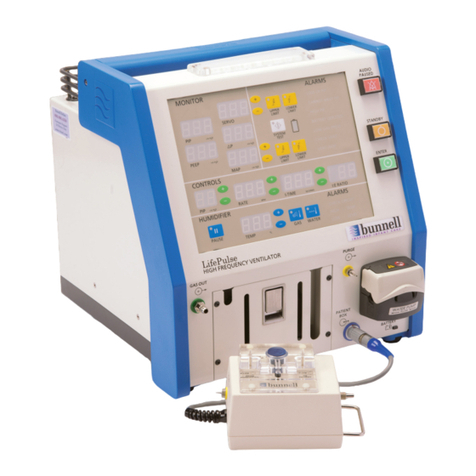
Bunnell LifePulse HFV User Manual | 8
PROLOGUE
WARNING: Do not initiate ventilation with kinks or obstructions
present in the Patient Circuit or LifePort pressure monitoring
tube. Doing so may result in alarms or delays in ventilator
support. Pressures may be generated that are too high or too
low for the patient’s needs.
WARNING: Do not leave the patient’s bedside while the LifePulse
water pump is running during initial start-up or following a circuit
change. A properly trained person must observe the cartridge fill
with sterile water for inhalation, USP, to the second water level
sensing pin and the water pump stops pumping.
WARNING: The LifePulse will not detect extubation of a
patient during start-up (i.e., from the time the ENTER button is
pushed until the Ready indicator is illuminated). During start-up
the ventilator may appear to be functioning normally despite
extubation and will generate no audible or visual alarms. A
properly trained individual must verify the patient is being
ventilated following start-up.
WARNING: There will be no LOSS OF PIP alarm for the first 15
seconds after the ENTER button is pushed. A properly trained
person must observe the LifePulse reach the set PIP and the Ready
indicator illuminate before leaving the patient’s bedside.
WARNING: Do not press the ENTER button during a LOSS
OF PIP alarm with the Ready indicator illuminated if the patient
is stable and the Servo has locked at or near an established
operating value. Doing so will temporarily silence the audible
alarm and unlock the LifePulse Servo. Always troubleshoot the
potential causes of an alarm following the guidelines in the User
Manual prior to pressing the ENTER button.
WARNING: Always troubleshoot a change in Servo that is greater
than 1.0 psi (6.89 kPa) from the previously established baseline,
especially if the LifePulse control settings have not been changed.
Servo changes this large or larger usually represent a mechanical
problem and may pose a risk of volutrauma.
WARNING: The patient is not being ventilated by the LifePulse
during VENT INOP Alarms 01 & 05-09, which place the LifePulse
in Standby mode.
WARNING: The patient is not being ventilated by the LifePulse
during VENT INOP Alarm 10, which places the LifePulse into
Standby mode. Always troubleshoot the potential causes of an
alarm following the guidelines in the User Manual prior to pressing
the ENTER button. Pressing the ENTER button will re-initiate
ventilation immediately.
WARNING: Do not manually adjust alarm limits around MAP and
Servo to the point that they become irrelevant (i.e., are effectively
off). Doing so will negate critical alarms and expose the patient to
potentially unsafe conditions that may result in injury.
WARNING: Do not manually adjust the alarm volume to the point
that the audible alarm cannot be recognized (is effectively off).
Doing so will limit the LifePulse’s ability to alert clinicians to alarm
conditions and expose the patient to potentially unsafe conditions
that may result in injury.
WARNING: The conventional ventilator rate should not exceed
10 breaths per minute when running in tandem with the LifePulse
ventilator. Doing so could result in excessive Mean Airway
Pressure or minute volume being delivered to the patient. The
recommended conventional ventilator rate is 0 - 5 breaths per
minute.
NOTE:PIP, MAP, and PEEP are reported as approximate tracheal
pressures and are measured inside the LifePort adapter. They may
not accurately reflect alveolar pressures and, in fact, may be higher
or lower than alveolar pressures.
WARNING: Always evaluate inadvertent PEEP (LifePulse
monitored PEEP greater than CV set PEEP). The patient’s lung
volume should be assessed when inadvertent PEEP is present.
Inadvertent PEEP reduces delta pressure, which may result in
under-ventilation (hypercarbia).
WARNING: Place the LifePulse ventilator in Standby mode prior
to suctioning to avoid fluctuations in the monitored pressures that
may result in alarm conditions or possible injury to the patient.
WARNING: The LifePulse must be in Ready mode prior to
suctioning if suctioning while the LifePulse is running. Failure to do
so may result in inappropriate pressure or volumes being delivered
to the patient.
WARNING: Place the LifePulse in Standby mode before unkinking
any portion of the Patient Circuit. This action prevents the patient
from being exposed to inappropriately high pressure or large
volume delivery (volutrauma).
WARNING: Do not press the PUSH TO LOAD button on the
Patient Box while the LifePulse is running on a patient. Doing so
could result in the patient being exposed to inappropriately high
pressures or large volume delivery (volutrauma).
WARNING: Do not tip the humidifier cartridge while removing it
from the cartridge housing if the Patient Circuit is connected to
the patient’s ET tube via the LifePort adapter. Doing so may result
in water spilling into the Patient Circuit and a bolus of water being
delivered to the patient.
WARNING: Do not open the water pump door while the pump is
pumping. Doing so may result in a pinch hazard to the operator.





























